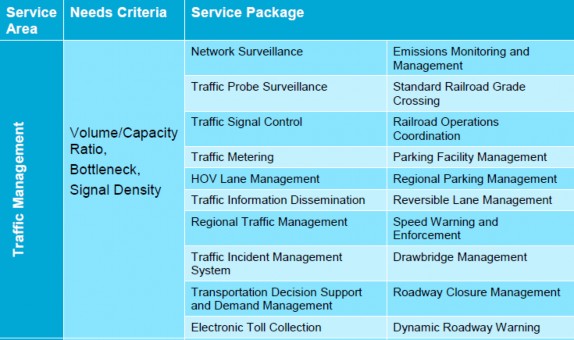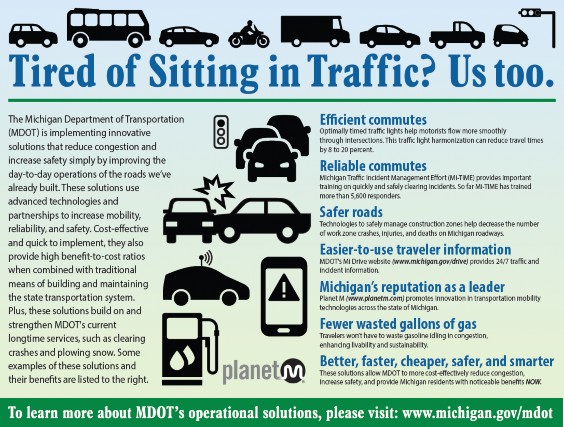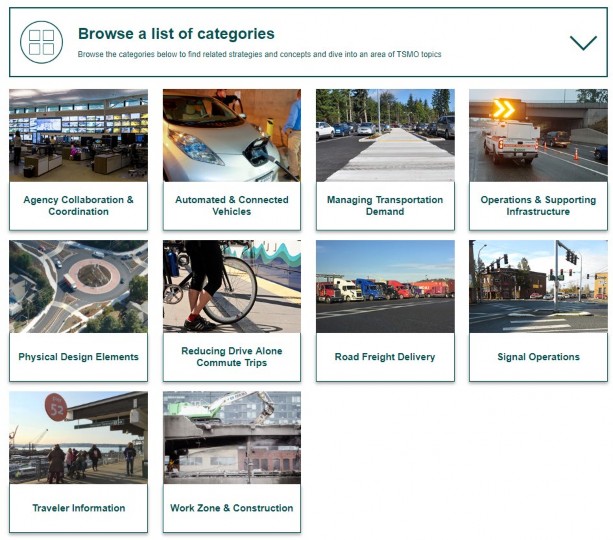Organizing for TSMO
Case Study 4: Culture - Changing the Culture Towards TSMO in State Departments of Transportation
Chapter 2 - Best Practices Examples
The Colorado Department of Transportation (CDOT), the Florida Department of Transportation District 4 (FDOT D4), the Iowa Department of Transportation (IowaDOT), the Michigan Department of Transportation (MDOT), and the Washington State Department of Transportation (WSDOT) all participated in previous second Strategic Highway Research Program (SHRP2) efforts. The capability maturity model (CMM) workshops with SHRP2 helped inform them about implementing and advancing transportation systems management and operations (TSMO) in their agencies. This chapter highlights how each agency has improved the TSMO culture in their State.
Colorado Department of Transportation (CDOT)
CDOT is composed of five regions with a largely centralized organization. CDOT manages highway facilities, including over 35 mountain passes where inclement weather poses additional challenges for safety and mobility. A TSMO division was initiated in 2015 to provide statewide programs and strategies to improve travel time reliability and safety.
TSMO Evaluation
Following the CMM assessment during SHRP2 efforts, CDOT developed or enhanced agency processes to improve their TSMO culture. Initially, the CDOT TSMO group worked to develop an "operations clearance" similar to environmental clearances, which would be required during project development. This process was provided to regional traffic groups and project managers but received some pushback from regional staff because it seemed like additional work and the benefit was not understood. To mitigate this perception, CDOT used the Lean Six Sigma methodology to modify the original operations clearance process into a TSMO project evaluation tool that effectively presented the benefits of TSMO without a large amount of additional work. With support of agency executive staff, CDOT developed a "Lean Team" that included personnel from various disciplines with responsibility for evaluating the original operations clearance process. This support from senior level management communicated the importance of TSMO and the TSMO evaluation tool to other staff. CDOT trained staff on how and when to use the TSMO evaluation tool. This tool was made up of three assessments: safety, operations, and intelligent transportation systems (ITS) and was required for scoping all projects after February 1, 2016. Once CDOT staff began using the evaluation tool in project planning, support for the TSMO program grew throughout the agency.
Various Outreach
Following the CMM assessment, the agency also provided training for numerous TSMO activities, including traffic incident management, general TSMO information, maintenance training academy, programs for highway incident commanders, and traffic management center operator training. CDOT produced TSMO newsletters and a brochure (see Figure 2) and held webinars and regional operations forums to communicate the value of TSMO and ongoing TSMO activities. These outreach materials and activities helped facilitate an improved TSMO culture in the agency by effectively communicating information, challenges, benefits, and success stories to agency staff.
Florida Department of Transportation District 4 (FDOT D4)
FDOT D4 is one of seven districts in Florida. It covers five counties and spans nearly 5,000 square miles. Over 3,600,000 residents travel around 52.4 million vehicle miles daily on roads in the FDOT D4 region. This area is also served by 90 airports, three deep-water ports, and two railroads.3 The TSMO Division of FDOT is part of the Traffic Engineering and Operations Office and is responsible for managing the State's ITS program, which facilitates mobility strategies and programs.
Regional Technical Advisory TSMO Committee
Following FDOT's involvement with SHRP2 efforts, FDOT D4 developed a TSMO regional technical advisory committee to collaborate with metropolitan planning organizations (MPO) on TSMO in the region. This committee also included regional partners from FDOT District 6, such as Miami-Dade County.
The technical advisory committee collaborated to develop an implementation plan for education and programming of TSMO projects in the region and covered varying topics for regional planning. Through this committee, FDOT D4 provides guidance to the MPO for TSMO activities so that TSMO is included in regional planning efforts and project implementation. Additional efforts are made for local discussions because funding for TSMO activities varies throughout the region.
The FDOT D4 TSMO culture has grown in part from discussions and action items developed during these collaborative committee meetings. The committee provides TSMO program updates and examples of successful projects using TSMO strategies. Presenting case studies, such as benefits received from adaptive control or managing a major event, to committee planners helps communicate regional needs and how TSMO can support cost-efficient solutions and enhance the regional TSMO culture.
TSMO Master Plan
The D4 TSMO Master Plan for Broward and Palm Beach Counties defines the first identified TSMO network in the region. This TSMO network was established using five criteria: volume-to-capacity ratios, signal density, bottlenecks, transit ridership, and crash density. The plan identifies where TSMO projects are needed, what type of projects are needed, when and how they should be implemented, and who is responsible for each phase of project development. Figure 3 from the Master Plan communicates the TSMO service areas, criteria, and solutions for regional transportation challenges.
 Figure 3. Chart. Excerpt from TSMO Service Areas and Criteria Table
Source: Transportation Systems Management and Operations Master Plan, FDOT D4
Figure 3. Chart. Excerpt from TSMO Service Areas and Criteria Table
Source: Transportation Systems Management and Operations Master Plan, FDOT D4
The first release of this master plan included descriptions to effectively define TSMO and promote the value it brings to transportation planning, design, construction, and maintenance. The agency took a simple approach when writing the document to ensure TSMO goals and objectives were effectively communicated to personnel from all disciplines. The agency noted that this approach to communication has greatly improved the agencywide TSMO culture. A decision was made to ensure that this master plan would be mainstreamed into existing planning processes during a series of value engineering workshops by tasking the planning group, versus traffic operations, to develop the TSMO Master Plan. This approach, alongside support from district executive leadership, helped integrate the plan and facilitated an improved TSMO culture.
Looking to the Future
Based on previous efforts, FDOT D4 identified next steps to improve the TSMO culture. The district plans to update the master plan to include strategic direction from other regional transportation plans such as incident management, arterial management, managed lanes, and more. These plans will be integrated into the FDOT D4 TSMO Master Plan, which will identify how each existing plan relates to different parts of TSMO, such as organization and staffing, budgeting, business process, and more. The inclusion of these transportation plans into the TSMO Master Plan will help communicate the business case to regional partners, executive leadership, and internal staff.
In the future, FDOT D4 also plans to improve the TSMO culture by working more closely with internal partners from bridge and hydrology design, maintenance, and others. The TSMO group recently began working with their bridge inspection group and created a proposal that considers the effect of movable bridges on maintenance, congestion, and safety. They began working with agency hydrology engineers to identify areas of frequent hydroplaning and correlating it with roadway infrastructure improvements. The cross-discipline collaboration that occurs between the TSMO group and other groups in the agency facilitates a wide understanding of the needs each group has when developing projects and promotes an improved multi-discipline understanding of TSMO. In the future, FDOT D4 intends to improve and formalize this process. The District's TSMO Program Engineer noted that it takes a lot of work to initiate and facilitate an improved TSMO culture, but it is "part of the job."
Iowa Department of Transportation (IowaDOT)
The Office of Traffic Operations is part of the Highway Division of IowaDOT. The Highway Division's responsibilities include design/planning, maintenance, construction, operations, and support of ITS technology. IowaDOT is divided into six geographical districts, each responsible for maintaining the State highway system in their respective region. IowaDOT's first TSMO plan was released in early 2016 by the Office of Traffic Operations. Since its release, IowaDOT continues to improve TSMO processes and expand their TSMO program.
TSMO Education
IowaDOT developed methods to improve their TSMO culture that included educating agency staff, regional partners, and the public. On their TSMO website, IowaDOT provides an informational video that explains TSMO and how it helps the traveling public, clips of which are shown in Figure 4.
IowaDOT's TSMO website also provides access to the agency's TSMO Strategic Plan and TSMO Program Plan as well as links to national resources for TSMO education, best practices, and national research. This form of TSMO communication reaches a large audience through its easy accessibility.
During development of IowaDOT's TSMO program, the business case for TSMO was not well understood agencywide. To mitigate this challenge, IowaDOT is working to develop educational information for staff such as a TSMO education video that will be provided to all agency personnel. Training materials are being customized for various audiences. For example, one set of materials are tailored for field staff and another for office staff. In the future, the agency plans to develop multi-discipline training material to help agency staff understand their role in transportation operations. As the program continues to grow, additional technical training will be developed and more support will be given to regional operations forums.
Michigan Department of Transportation (MDOT)
MDOT is responsible for Michigan's 9,669-mile State highway system. MDOT also administers other State and federal transportation programs for aviation, intercity passenger services, rail freight, local public transit services, and the Transportation Economic Development Fund.
Developing a Business Case for all Audiences
A TSMO business case identifies the benefits of implementing TSMO to mitigate common transportation challenges including congestion, funding, and safety. These cases are historically used to gain support or buy-in from regional partners, executive leadership, and the general public. MDOT has taken a unique approach to communicating their business case for TSMO to all audiences by developing five TSMO Business Cases for specific stakeholders. The five business cases have been prepared for the general public, legislators, partners, MDOT decision makers, and MDOT technical staff (see Figure 5 and Figure 6).
 The Michigan Department of Transportation (MDOT) is implenting innovative solutions that reduce congestion and increase safety simply by improving the day-to-day operations of the roads we've already built. These solutions use advanced technologies and partnerships to increase mobility, reliability, and safety. Cost-effective and quick to implement, they also provide high benefit-to-cost ratios when combined with traditional means of building and maintaining the state transportation system. Plus, these solutions build on and strengthen MDOT's current longtime services, such as clearing crashes and plowing snow. Some examples of these solutions and their benefits are listed to the right. Efficient commutes - Optimally timed traffic lights help motorists flow more smoothly through intersections. This traffic light harmonization can reduce travel times by 8 to 20 percent. Reliable commutes - Michigan Traffic Incident Management Effort (MI-TIME) provides important training on quickly and safely clearing incidents. So far MI-TIME has trained more than 5,600 responders. Safer roads - Technologies to safely manage construction zones help decrease the number of work zone crashes, injuries, and deaths on Michigan roadways. Easier-to-use traveler information MIDOT's MI Drive website (www.michigan.gov/drive) provides 24/7 traffic and incident information. Michigan's reputation as a leader - Planet M (www.planetm.com) promotes innovation in transportation mobility technologies across the state of Michigan. Fewer wasted gallons of gas - Travelers won't have to wase gasoline idling in congestion, enhancing livability and sustainability. Better, faster, cheaper, safer, and smarter - These solutions allow MIDOT to more cost-effectively reduce congestion, increase safety, and provide Michigan residents with noticeable benefits NOW.
Figure 5. Chart. MDOT's TSMO Business Case for the General Public
Source: https://www.michigan.gov/tsmo
The Michigan Department of Transportation (MDOT) is implenting innovative solutions that reduce congestion and increase safety simply by improving the day-to-day operations of the roads we've already built. These solutions use advanced technologies and partnerships to increase mobility, reliability, and safety. Cost-effective and quick to implement, they also provide high benefit-to-cost ratios when combined with traditional means of building and maintaining the state transportation system. Plus, these solutions build on and strengthen MDOT's current longtime services, such as clearing crashes and plowing snow. Some examples of these solutions and their benefits are listed to the right. Efficient commutes - Optimally timed traffic lights help motorists flow more smoothly through intersections. This traffic light harmonization can reduce travel times by 8 to 20 percent. Reliable commutes - Michigan Traffic Incident Management Effort (MI-TIME) provides important training on quickly and safely clearing incidents. So far MI-TIME has trained more than 5,600 responders. Safer roads - Technologies to safely manage construction zones help decrease the number of work zone crashes, injuries, and deaths on Michigan roadways. Easier-to-use traveler information MIDOT's MI Drive website (www.michigan.gov/drive) provides 24/7 traffic and incident information. Michigan's reputation as a leader - Planet M (www.planetm.com) promotes innovation in transportation mobility technologies across the state of Michigan. Fewer wasted gallons of gas - Travelers won't have to wase gasoline idling in congestion, enhancing livability and sustainability. Better, faster, cheaper, safer, and smarter - These solutions allow MIDOT to more cost-effectively reduce congestion, increase safety, and provide Michigan residents with noticeable benefits NOW.
Figure 5. Chart. MDOT's TSMO Business Case for the General Public
Source: https://www.michigan.gov/tsmo
TSMO Implementation and Strategic Plan
Following the 2013 CMM assessment, MDOT identified the need to create a TSMO implementation plan to help mature their capabilities in each of the six CMM dimensions. The implementation plan identifies MDOT's ten core TSMO business areas. The agency administered ten outreach events, one for each business area, to identify challenges, successes, capability maturity, and action items for future growth. Development of MDOT's "TSMO Umbrella," shown in Figure 7, resulted in between 12 and 24 action items for each TSMO business area.
 Figure 7. Chart. MDOT's TSMO Umbrella
Source: Transportation Systems Management and Operations Implementation and Strategic Plan, MDOT 2019
Figure 7. Chart. MDOT's TSMO Umbrella
Source: Transportation Systems Management and Operations Implementation and Strategic Plan, MDOT 2019
Action items were developed into a matrix to support capability strengthening in each TSMO business area. An example of an action item matrix to improve TSMO culture through outreach for one of MDOT's business areas is shown in Figure 8.
 Figure 8. Chart. Example Action Item Matrix
Source: Transportation Systems Management and Operations Implementation and Strategic Plan, MDOT 2019
Figure 8. Chart. Example Action Item Matrix
Source: Transportation Systems Management and Operations Implementation and Strategic Plan, MDOT 2019
Since the first implementation plan was completed, MDOT is focusing on the culture shift needed, which revolves around financing TSMO activities. The 2019 TSMO Implementation and Strategic Plan will provide an update of matrices and action items and a history of TSMO and operations in the agency showing how funding TSMO activities can improve legacy processes.
The agency noted that workshop involvement was critical to improving the TSMO culture in the State through developing the implementation plan. Three-day workshops provided opportunities for regional partners to gain a better understanding of the benefits TSMO brings to the State and how their involvement developing the plan facilitated multi-agency and multi-discipline ownership of the TSMO program's success. A summary of the 2018 TSMO Plan Maintenance Workshop is provided in an appendix to the 2019 Implementation and Strategic Plan.
Washington State Department of Transportation (WSDOT)
WSDOT supports changing transportation needs of the State of Washington through six regional districts. WSDOT operates and maintains more than 18,600 miles of highway lanes, nearly 3,300 bridge structures, and runs a ferry system that moves 24.2 million passengers and 10 million vehicles per year.
Business Processes Result in Improved Culture
After completing the CMM assessment during SHRP2 efforts, WSDOT realized the need for other internal and external groups to be engaged with transportation operations. Identifying how to sell TSMO to the agency holistically was one of their initial challenges to improving the TSMO culture. To counter this challenge, WSDOT began advocating for TSMO through development of business processes. They prioritized business processes during their Workshop on TSMO Program Planning with items such as TSMO planning and budgeting, based on their opinion that business processes and culture directly affect each other. WSDOT plans to use their TSMO plan as the means to improve both business processes and culture. The agency performed several outreach activities, working with "grassroots" staff members to communicate the value and effectiveness of TSMO and the role it plays daily in activities throughout the agency. WSDOT feels this outreach made the highest impact on improving the agency's TSMO culture.
TSMO Educational Website
Additionally, WSDOT developed a TSMO website to promote the value of TSMO for use by internal staff and regional partners. The website provides TSMO education, the "when-why-how" to use TSMO, and how to deploy TSMO strategies. Figure 9 shows highlights from the website of various transportation strategies and concepts and provides links to educational explanations of solutions that can mitigate these challenges.
 Figure 9. Illustration. WSDOT TSMO Website - Transportation Strategies and Concepts
Source: https://tsmowa.org
Figure 9. Illustration. WSDOT TSMO Website - Transportation Strategies and Concepts
Source: https://tsmowa.org
The WSDOT TSMO website has helped to improve the TSMO culture for the region by providing readily accessible information and transparency regarding regional transportation challenges as well as the goals and objectives of WSDOT's TSMO program. The agency has had great success with the website and additional funding has been allocated to release an updated version in the summer of 2019. A link to this educational website is provided in the references section of this report.
WSDOT also noted that having a TSMO champion to support TSMO outreach activities has helped to enhance their TSMO culture. This champion continually advocates for TSMO in the agency and facilitates discussion for future improvement.